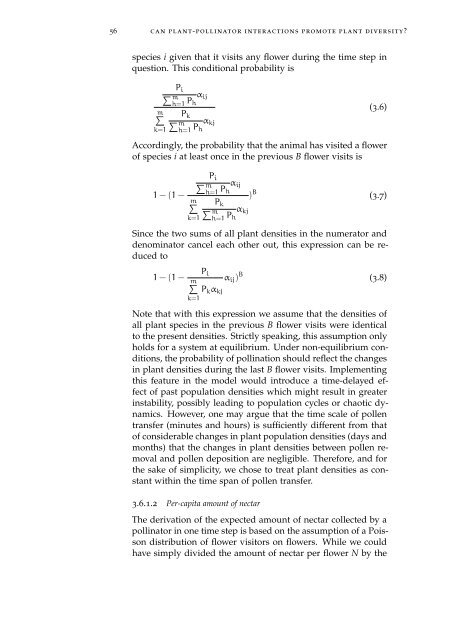Linking Specialisation and Stability of Plant ... - OPUS Würzburg
Linking Specialisation and Stability of Plant ... - OPUS Würzburg
Linking Specialisation and Stability of Plant ... - OPUS Würzburg
You also want an ePaper? Increase the reach of your titles
YUMPU automatically turns print PDFs into web optimized ePapers that Google loves.
56 can plant-pollinator interactions promote plant diversity?<br />
species i given that it visits any flower during the time step in<br />
question. This conditional probability is<br />
P i<br />
∑ mh=1<br />
P h<br />
α ij<br />
m∑<br />
k=1<br />
(3.6)<br />
P k<br />
∑ mh=1 α kj<br />
P h<br />
Accordingly, the probability that the animal has visited a flower<br />
<strong>of</strong> species i at least once in the previous B flower visits is<br />
1 − (1 −<br />
P i<br />
∑ mh=1<br />
P h<br />
α ij<br />
m∑<br />
k=1<br />
) B (3.7)<br />
P k<br />
∑ mh=1 α kj<br />
P h<br />
Since the two sums <strong>of</strong> all plant densities in the numerator <strong>and</strong><br />
denominator cancel each other out, this expression can be reduced<br />
to<br />
1 − (1 −<br />
P i<br />
α m∑ ij ) B (3.8)<br />
P k α kj<br />
k=1<br />
Note that with this expression we assume that the densities <strong>of</strong><br />
all plant species in the previous B flower visits were identical<br />
to the present densities. Strictly speaking, this assumption only<br />
holds for a system at equilibrium. Under non-equilibrium conditions,<br />
the probability <strong>of</strong> pollination should reflect the changes<br />
in plant densities during the last B flower visits. Implementing<br />
this feature in the model would introduce a time-delayed effect<br />
<strong>of</strong> past population densities which might result in greater<br />
instability, possibly leading to population cycles or chaotic dynamics.<br />
However, one may argue that the time scale <strong>of</strong> pollen<br />
transfer (minutes <strong>and</strong> hours) is sufficiently different from that<br />
<strong>of</strong> considerable changes in plant population densities (days <strong>and</strong><br />
months) that the changes in plant densities between pollen removal<br />
<strong>and</strong> pollen deposition are negligible. Therefore, <strong>and</strong> for<br />
the sake <strong>of</strong> simplicity, we chose to treat plant densities as constant<br />
within the time span <strong>of</strong> pollen transfer.<br />
3.6.1.2 Per-capita amount <strong>of</strong> nectar<br />
The derivation <strong>of</strong> the expected amount <strong>of</strong> nectar collected by a<br />
pollinator in one time step is based on the assumption <strong>of</strong> a Poisson<br />
distribution <strong>of</strong> flower visitors on flowers. While we could<br />
have simply divided the amount <strong>of</strong> nectar per flower N by the
















